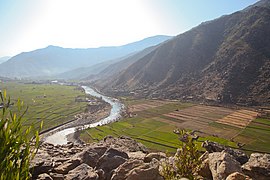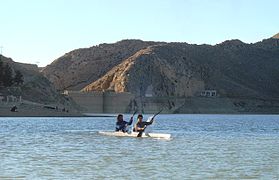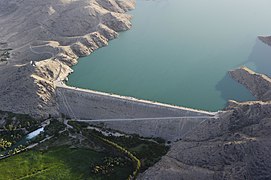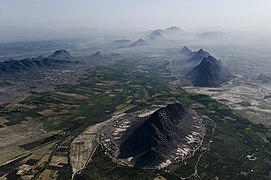Pashtunistan
Pashtunistan
پښتونستان | |
|---|---|
| Time zone | UTC+04:30 (Afghanistan) UTC+05:00 (Pakistan) |
| Largest cities | |
Pashtunistan (
During
| Part of a series on |
| Pashtuns |
|---|
| Empires and dynasties |
The 16th-century revolutionary leader
Origin of term
The name used for the region during the
The Pashto name Pakhtunistan or Pashtunistan (
The native people
The native or
The Pashtuns practice Though this was common before the war on terror but after several military operations conducted in FATA, this cross border movement is checked via military and has become much less common in comparison to the past.
Depending on the source, the ethnic Pashtuns constitute 42-60% of the
History

Since the
Delhi Sultanate and the last Afghan Empire

During the
After the death of Nader Shah in 1747 and the disintegration of his massive empire, Ahmad Shah Durrani created his own large and powerful Durrani Empire, which included all of modern-day Afghanistan, North east Iran, Sindh, Punjab, Baluchistan and Kashmir. The famous couplet by Ahmad Shah Durrani describes the association the people have with the regional city of Kandahar:
"Da Dili takht herauma cheh rayad kam zama da khkule Pukhtunkhwa da ghre saroona". Translation: "I forget the throne of Delhi when I recall the mountain peaks of my beautiful Pukhtunkhwa."
The last Afghan Empire was established in 1747 and united all the different Pashtun tribes as well as many other ethnic groups. Parts of the Pashtunistan region around Peshawar was invaded by Ranjit Singh and his Sikh army in the early part of the 19th century, but a few years later they were defeated by the British Raj, the new powerful empire which reached the Pashtunistan region from the east.
European influence

Following the decline of the
During World War I, the Afghan government was contacted by the
Similarly, during the 1942 Cripps Mission, and 1946 Cabinet Mission to India, the Afghan government made repeated attempts to ensure that any debate about the independence of India must include Afghanistan's role in the future of the NWFP. The British government wavered between reassuring the Afghan to the rejection of their role and insistence that NWFP was an integral part of British India.[50]
During World War II, the government of Nazi Germany proposed an alliance with neutral Afghanistan in order to destabilize British control over the north-west of its domain in India. In return, the Afghans sought that NWFP and the Port of Karachi would be ceded to the Kingdom of Afghanistan with German military aid, so that it could gain valuable access to the Arabian Sea.[51] Such a plan would require annexation of NWFP, Baluchistan and Sindh provinces.
The
Bannu Resolution
In June 1947,

1947 NWFP referendum
The NWFP joined the
Independence of Pakistan in 1947
The concept of Pashtunistan has varying meanings across Pakistan and Afghanistan.[58] In Afghanistan, Pashtun nationalists look after the interests of the Pashtun ethnic group and have support only from them.[59] They favor the ideas of Lōy Afghānistān or "Greater Afghanistan", and maintain an irredentist claim on the entire Pashtun-populated region.[59][60] The Pashtunistan demand also served the cause of domestic Afghan politics, where several successive governments used the idea to strengthen "Pashtun ethnic support" for the state. This policy intensified ethno-linguistic rivalry between Pashtuns and non-Pashtuns in the country.[58] These claims are contested in Pakistan, where Pashtun politics centers on political autonomy rather than irredentist politics.[27]
Since the late 1940s with the dissolution of British India and
An important development in Pakistan during the Ayub period (1958–1969) was the gradual integration into Pakistani society and the military-bureaucratic establishment. It was a period of Pakistan's political history which saw a large number of ethnic Pashtuns holding high positions in the military and the bureaucracy. Ayub himself was a non-Pashto speaking ethnic Pashtun belonging to the Tarin sub-tribe of the Hazara District in the Frontier. The growing participation of Pashtuns in the Pakistani Government resulted in the erosion of the support for the Pashtunistan movement in the Province by the end of the 1960s.[27]
Afghanistan and Pashtun nationalists did not exploit Pakistan's vulnerability during the nation's
Sardar
Pakistani government decided to retaliate against the Afghan government's Pashtunistan policy by supporting Non-Pashtun opponents of the Afghan government including future Mujaheddin leaders like
Bacha Khan who previously strived greatly for Pashtunistan later on in 1980 during an interview with an Indian journalist, Haroon Siddiqui said that the "idea of Pashtunistan never helped Pashtuns. In fact it was never a reality". He further said that "successive
In 1976, the then president of Afghanistan,
Daoud would be overthrown by Khalqist military officers in 1978 leading to the formation of the Democratic Republic of Afghanistan which was dominated by Pashtun Khalqists who would go on to "reopen the Pashtunistan wound". In 1979 under General Secretary Nur Muhammad Taraki the Khalqists regime in Afghanistan changed the official map to include NWFP and Balochistan as new "frontier provinces" of the DRA.[75] The Khalqist regime also sought to make Pashto the sole language of the Afghan government and the lingua franca, they did so by undermining Dari.[76] The Afghan anthem under the communist regime was only in Pashto and not Dari with non-Pashtuns being required to sing it in Pashto.[77] Up until the overthrow of Dr Najibullah's Homeland Party regime in 1992, Afghan governments had favored Pashto in the media and over 50% of Afghan media was in Pashto.[76] After 1992 with the formation of the Tajik led Islamic State of Afghanistan, this number dropped drastically.[76]
Following the outbreak of the
20th and 21st century



Pashtuns in Pakistan make up the second largest ethnic group after
There are more than 19 million Pashtuns in Afghanistan, constituting 48% of the population. Other sources say that up to 60% of Afghanistan's population is made up of ethnic Pashtuns, forming the largest ethnic group in that country. Pashto is one of the
Important government positions in Afghanistan have historically been held by Pashtuns. The Afghan Armed Forces was also traditionally dominated by Pashtuns however the fall of the Najibullah regime in 1992 led to the creation of the Tajik dominated Islamic State of Afghanistan.[82]
The majority of the Afghan Taliban[83] are ethnic Pashtuns,[84] with past Pashtun leaders such as Mullah Mohammed Omar, Mohammad Rabbani and Jalaluddin Haqqani. The current leaders of the Taliban include Pashtuns such as Abdul Kabir, Hibatullah Akhundzada and Sirajuddin Haqqani.
Afghanistan makes its claim on the Pashtun areas on the ground that it served as the Pashtun seat of power since 1709 with the rise of the
Agreements cited by the Afghan government as proof of their claim over the Pashtun tribes include Article 11 of the
The Durand Line and Pashtunistan issues have been raised by different Afghan regimes in the past. However, it may no longer be a concern. Pashtuns are now so well integrated in Pakistani society that the majority will never opt for Pashtunistan or Afghanistan. Afghan-Pashtun refugees have been staying in Khyber Pakhtunkhwa for more than 30 years. Threat perceptions about Afghanistan need re-evaluation so that suitable changes are made in our Afghan policy.[87]
— Asad Munir, Retired brigadier who has served in senior intelligence postings in Khyber-Pakhtunkhwa and FATA
Khyber Pakhtunkhwa
Prominent 20th century proponents of the Pashtunistan cause have included
There was support, however, to rename North-West Frontier Province (NWFP) as Pakhtunkhwa (which translates as "area of Pashtuns"). Nasim Wali Khan (the wife of Khan Abdul Wali Khan) declared in an interview: "I want an identity. I want the name to change so that Pathans may be identified on the map of Pakistan..."[88]
On 31 March 2010, Pakistan's Constitutional Reform Committee agreed that the province be named and recognized as
This is now the official name for the former NWFP.Gallery
- Images of the Pashtunistan region
-
Asadabad, capital of Kunar Province in Afghanistan
-
Pech River Valley
-
Watapur District of Kunar Province
-
Branches of the Kunar River meet in Nangarhar Province
-
Kabul River in Jalalabad, Afghanistan
-
Khyber Pass in Khyber Pakhtunkhwa, Pakistan
-
People attendingKhost University in Khost, Afghanistan
-
Ghazni Province, Afghanistan
-
Afghan Border Police (ABP) in Paktika Province
-
Kuchi people in Paktia Provinceof Afghanistan
-
Hanna Lake in Quetta, Pakistan
-
Kandahar Province, Afghanistan
-
Helmand River in Helmand Province, Afghanistan
See also
- Afghan Millat Party
- Khalq
- Awami National Party
- Bacha Khan
- Bannu Resolution
- Durand Line
- Greater Iran
- Manzoor Pashteen
- Pashtunistan conflict
- Pashtun nationalism
- Pashtunization
- Pashtunkhwa Milli Awami Party
- Pashtun Tahafuz Movement
- Qabailistan
References
- ^ a b "Pakistan population: 187,342,721 [Pashtun (Pathan) 15.42%]". The World Factbook. Central Intelligence Agency (CIA). 2011. Archived from the original on June 13, 2007. Retrieved 2012-02-10.
- ^ "Afghanistan population: 30,419,928 (July 2012 est.) [Pashtun 42%] = 12,776,369". The World Factbook. Central Intelligence Agency (CIA). Archived from the original on July 26, 2009. Retrieved 20 September 2010.
- ^ Lewis, Paul M. (2009). "Pashto, Northern". SIL International. Dallas, Texas: Ethnologue: Languages of the World, Sixteenth edition. Retrieved 18 September 2010.
Ethnic population: 49,529,000 possibly total Pashto in all countries.
- Pashto language: Dialectsfor further information.
- )
- ^ Roddy, Stephen J.; Sharma, Shalendra D., eds. (1 May 2002). "Asia Pacific: Perspectives" (PDF). University of San Francisco. Archived from the original (PDF) on 4 August 2019. Retrieved 15 March 2023.
- ISBN 9781598846607– via Google Books.
- ISBN 81-7890-056-4. Retrieved 2010-09-10.
- ^ "The History of Herodotus Chapter 7". Translated by George Rawlinson. The History Files. Archived from the original on 2012-02-05. Retrieved 2007-01-10.
- ISBN 90-04-08265-4. Retrieved 2010-09-24.
- ISBN 9780852297605.
Ghaffar Khan, who opposed the partition, chose to live in Pakistan, where he continued to fight for the rights of the Pashtun minority and for joining Afghanistan. Afghanistan means literally land of the pashtun people! the Homeland of the Pashtuns is Afghanistan
- ^ The Modern Review, Volume 86. Prabasi Press Private. 1949.
The Afghan Government is actively sympathetic towards their demand for a Pathanistan. It has been declared by the Afghan Parliament that Afghanistan does not recognise the Durand line...
- ^ The Spectator. Vol. 184. F.C. Westley. 1950.
Instead it adopted the programme of an independent "Pathanistan" — a programme calculated to strike at the very roots of the new Dominion. More recently the Pathanistan idea has been taken up by Afghanistan.
- ^ "Hindi music 'has roots in Hindu Kush's Pashtoon belt'". The Express Tribune. 17 January 2023. Retrieved 2023-02-19.
- ISBN 978-0-8047-7666-0.
A majority of Pashtuns live south of the Hindu Kush (the 500-mile mountain range that covers northwestern Pakistan to central and eastern Pakistan) and with some Persian speaking ethnic groups. Hazaras and Tajiks live in the Hindu Kush area, and north of the Hindu Kush are Persians and Turkic ethnic groups.
- ^ Synovitz, Ron. "Controversial Proposal Of 'Pashtunistan'". RadioFreeEurope/RadioLiberty.
- New York Times. Retrieved 2 October 2017.
- ^ "Abdul Ghaffar Khan". Encyclopædia Britannica. Retrieved 24 September 2008.
- ^ "Abdul Ghaffar Khan". I Love India. Retrieved 24 September 2008.
- ISBN 9781108621236.
- ^ "Partition and Military Succession Documents from the U.S. National Archives".
- ^ a b Electoral History of NWFP (PDF). Archived from the original (PDF) on 10 August 2013.
- ^ ISBN 9783319571560. Retrieved 25 July 2017.
- ISBN 9780786724819. Retrieved 10 July 2013.
- ^ "Was Jinnah democratic? — II". Daily Times. December 25, 2011. Retrieved February 24, 2019.
- ^ "Everything in Afghanistan is done in the name of religion: Khan Abdul Ghaffar Khan". India Today. Archived from the original on 8 January 2019. Retrieved 13 January 2014.
- ^ a b c Rizwan Hussain. Pakistan and the emergence of Islamic militancy in Afghanistan. 2005. p. 74.
- ^ "The Fata merger: What's happening now and what should happen next?".
- ^ "Afghan and Afghanistan". Abdul Hai Habibi. alamahabibi.com. 1969. Retrieved 2010-10-24.
- ^ Muhammad Qasim Hindu Shah (1560). "The History of India, Volume 6, chpt. 200, Translation of the Introduction to Firishta's History (p.8)". Sir H. M. Elliot. London: Packard Humanities Institute. Archived from the original on 2013-07-26. Retrieved 2010-08-22.
- ^ a b c Faultlines, Volume 18. Institute for Conflict Management. 2007. p. 59.
The name Pakhtunistan or in soft Pashtu dialect Pashtunistan evolved originally from the Indian word Pathanistan. The very concept of Pakhtunistan was taken from the old word Pakhtunkhwa. Obaidullah Sindhi used Pashtania for Pashtu speaking area of his Proposed People's Republic of India or Saro-Rajia-i-Hind (Obaidullah's letter to Iqbal Shaidai on 22 June 1924), Muhammad Aslam, Maulana Obaidullah Sindhi Kay Siasi Maktubat, Lahore: Niduatal Musanifeen, 1966, p. 34
- ^ a b "Pashtu Literature Part II". Pashtoonkhwa. Retrieved 2009-06-07.
The name Pakhtunistan or in soft Pashtu dialect Pashtunistan evolved originally from the Indian word Pathanistan. The very concept of Pakhtunistan was taken from the old word Pakhtunkhwa. The British, Indian leaders and even the Khudai Khidmatgars were using Pathanistan for Pakhtunistan in the beginning, but later on they started using the word Pakhtunistan.
- ^ "The Problem of Pukhtunistan". Khyber Gateway. Archived from the original on April 15, 2013. Retrieved 2009-06-07.
The word Pathanistan is not Persian but Indian. It shows that the Khalifa had already acquired the consent of the Muslim leaders of India or these leaders might have motivated the Khalifa to first liberate the Pukhtuns' land (Pathanistan) to build up a strong base against the British Empire in India
{{cite web}}: CS1 maint: unfit URL (link) - ^ Ahmed, Feroz (1998) Ethnicity and politics in Pakistan. Karachi. Oxford University Press.
- ISBN 978-0-618-81017-8. Retrieved 2010-08-22.
Even within the largest ethnic group, the Pashtuns (about 50 percent of the population)...
- ISBN 9780160118449. Retrieved 2010-09-24.
- ISBN 1-4289-1368-8. Retrieved 2010-09-24.
- ^ "AFGHANISTAN v. Languages". Ch. M. Kieffer. Encyclopædia Iranica. Retrieved 2010-10-24.
Paṧtō (1) is the native tongue of 50 to 55 percent of Afghans...
- ISBN 978-0-08-087774-7. Retrieved 2010-09-24.
Pashto, which is mainly spoken south of the mountain range of the Hindu Kush, is reportedly the mother tongue of 60% of the Afghan population.
- ISBN 1-876756-27-6. Retrieved 2010-09-24.
Over 60 percent of the population in Afghanistan is Pashtun...
- ^ "Why Pakistan's Pashtun Minority Won't Be Easily Crushed". American Enterprise Institute - AEI. 2018-06-25. Retrieved 2022-06-12.
- ^ "Pakistan Census report 1998". Government of Pakistan. 1998. Archived from the original on 2011-09-12. Retrieved 2010-10-29.
- ^ "Country Profile: Afghanistan" (PDF). Library of Congress. Library of Congress Country Studies on Afghanistan. August 2008. Retrieved 2010-09-10.
- ^ "Kingdoms of South Asia – Afghanistan (Southern Khorasan / Arachosia)". The History Files. Retrieved 2010-08-16.
- ^ John Ford Shroder. "Afghanistan – VII. History". Archived from the original on October 31, 2009. Retrieved 2009-10-31.
- ^ "You are being redirected..." www.astrojyoti.com.
- ISBN 9780761932260– via Google Books.
- ISBN 9780233050539.
- ^ "باچا خان مرکز میں کلاسیکل محفل موسیقی' نامور گلوکاروں سمیت نئے چہروں نے آواز کا جادو جگایا". The Khyberwatch (in Urdu). Archived from the original on 19 August 2011. Retrieved 15 March 2023.
- ISBN 978-0-275-97878-5, pp. 92-94
- S2CID 161835556.
- ^ "Past in Perspective". The Nation. August 25, 2019. Retrieved August 25, 2019.
- ^ Ali Shah, Sayyid Vaqar (1993). Marwat, Fazal-ur-Rahim Khan (ed.). Afghanistan and the Frontier. University of Michigan: Emjay Books International. p. 256.
- ISBN 9780804789219.
- ^ "Stamp: Pashtu Flag (Afghanistan(Pashtunistan Day (1957)) Mi:AF 454A,Sn:AF 443,Yt:AF 452,Sg:AF 420".
- ^ "Archived copy" (PDF). Archived from the original (PDF) on 10 August 2013. Retrieved 2013-12-28.
{{cite web}}: CS1 maint: archived copy as title (link) - ISBN 9780275978785. Retrieved 18 April 2015.
- ^ ISBN 978-0-19-022927-6.
- ^ ISBN 0-566-00651-0
- ^ Caron, James M (2009). Cultural Histories of Pashtun Nationalism, Public Participation, and Social Inequality in Monarchic Afghanistan, 1905-1960.
- ^ The Pashtunistan Issue, Craig Baxter (1997), Library of Congress Country Studies.
- ^ a b Bukhari, Farigh (1991). Taḥrīk-i āzādī aur Bācā K̲h̲ān. Fiction House. p. 226.
- ^ Paul Wolf. "Pashtunistan." Pakistan: Partition and Military Succession. 2004.
- ^ Saeedi, Sayed Ziafatullah (7 November 2018). "Daoud's Footprints: how Afghanistan's First President Influences Ghani". The Globe Post. Retrieved 1 March 2019.
- ^ a b "Everything in Afghanistan is done in the name of religion: Khan Abdul Ghaffar Khan". India Today. Retrieved 13 January 2014.
- ^ ISBN 9781610394123.
- ^ Venkataramakrishnan, Rohan (19 May 2013). "Send Section 66A bullies home". India Today. Retrieved 24 October 2016.
- ^ The Faqir of Ipi of North Waziristan. The Express Tribune. November 15, 2010.
- ^ The legendary guerilla Faqir of Ipi unremembered on his 115th anniversary. The Express Tribune. April 18, 2016.
- ^ "Afghanistan - Daoud as Prime Minister, 1953-63". countrystudies.us. Retrieved 2023-02-08.
- ^ "Remembering Our Warriors: Babar 'the great'." Archived 2016-04-28 at the Wayback Machine Interview of Maj. Gen. (Retd.) Naseerullah Khan Babar, by A. H. Amin. Defence Journal. April 2001. Retrieved 15 April 2010.
- ISBN 9781850438571.
- ISBN 9781850656838.
- ISBN 9781107112070.
- ISBN 0-8179-7792-9.
- ^ ISSN 0004-4687.
- ^ "Afghanistan (1978–1992)". nationalanthems.info. 9 May 2012. Retrieved 18 October 2017.
- ^ Bajoria, Jayshree (20 March 2009). "The Troubled Afghan-Pakistani Border". Council on Foreign Relations. Archived from the original on 25 May 2010. Retrieved 11 February 2011.
- ^ "Punja Sahib: The Miracle at Hassan Abdal". Wonders of Pakistan. 13 April 2009. Retrieved 6 May 2016.
- ^ "Afghanistan", The World Factbook, Central Intelligence Agency, 2024-02-01, retrieved 2024-02-14
- ^ "Afghan Geodesy and Cartography Head Office (AGCHO)". agcho.gov.af. Archived from the original on 2011-11-24.
- ISSN 0004-4687.
- ^ "Afghan government continues to lose ground to Taliban: SIGAR". www.aljazeera.com. Retrieved 2019-04-10.
- )
- H. G. Raverty(1898) Tarikh-e-Farishtah; Notes on Afghanistan; Peshawar District Gazetteer 1897-98.
- ^ a b Olaf Caroe. The Pathans 1981.
- ^ "Re-evaluation of our Afghan policy". Express Tribune. 15 May 2012. Retrieved 16 May 2012.
- ISBN 1843310309.
- ^ BBC News Online – Pakistan debates key amendment bill Retrieved 5 April 2010
- ^ Dawn News – Consensus reached on renaming NWFP Retrieved 5 April 2010
Further reading
- Ahmed, Feroz (1998) Ethnicity and politics in Pakistan. Karachi: Oxford University Press.
- Ahmad, M.(1989) Pukhtunkhwa Kiyun Nahin by Mubarak Chagharzai. pp. 138–139.
- Amin, Tahir (1988) -National Language Movements of Pakistan. Islamabad Institute of Policy Studies.
- Buzan, Barry and Rizvi, Gowher (1986), South Asian Insecurity and the Great Powers, London: Macmillan. p. 73.
- Fürstenberg, Kai (2012) Waziristan: Solutions for a Troubled Region in Spotlight South Asia, No. 1, ISSN 2195-2787 (https://web.archive.org/web/20150907205431/http://www.apsa.info/wp-content/uploads/2012/10/SSA-1.pdf)
- Caroe, Olaf (1983) The Pathans, with an Epilogue on Russia. Oxford University Press. pp. 464–465.















